Homesteading on the North Downs in Kent
from Maureen Boustred
The upland areas of Kent, the North and South Downs are shaped like a huge horse-shoe lying on its side with the open area facing East, and the ends of this horse-shoe ending abruptly in the cliffs of Dover. In the late nineteen sixties, In order to continue music studies, I arrived in North West Kent and lived in the area for over thirty years during which I made my home on the North Downs.
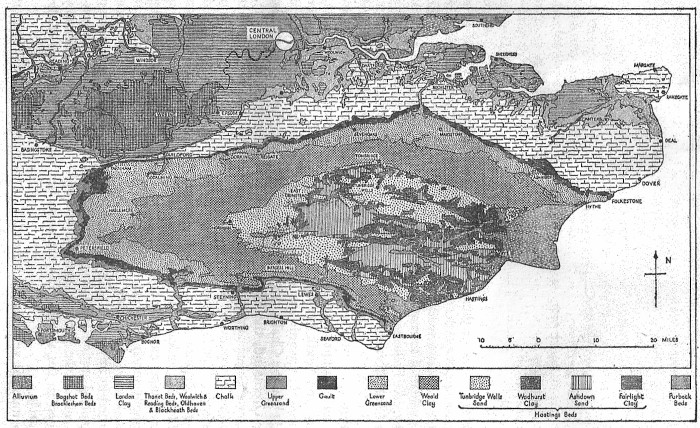 |
 |
Kent in the 1960's
"Starlings' Roost" was the name coined for the three-storey Kentish Ragstone building where those birds had taken over the space under the roof. I was living in the flat below but was not bothered by their chatter and clatter. When visiting the town Post Office I had learnt to duck as locally nesting swifts flew screaming round the corner on their low-flight feeding missions. The starlings did not present such a problem. One morning, I was awakened by twitterings and activity by the open window. A small flock of pretty little birds - house martins - were using the ledge as a temporary resting place and launching pad for short feeding flights. They did not stay long and soon continued on their migration flight south. They had come from over the North Downs where I was due to visit. My difficulty was how to make the journey. I certainly could not fly.
The answer came in the form of 'The Little Blue Bus'. This was a service owned and operated by an enterprising Doctor of Psychiatry who often did the driving. So, not long after the departure of the house martins, I stood at a local bus stop, and flagged down a blue mini bus. Dr. Heffernan courteously welcomed me aboard. Travelling northwards the bus left the town and crossed the valley of Holmesdale which divides the North Downs from the greensand ridge on which the town stands,
The chalk uplands
There is no running water on the Downs - no streams or brooks. The little valleys are dry. Rain falling on the summit seeps down through the surface layer of clay with flints, and then the main body of chalk until the flow is halted along the foot of the Downs by a strata of gault clay - good for growing top fruit. Water forced to the surface by the gault bubbles out along what is known as the 'spring-line'. 'Pilgrims going to Canterbury followed a route, still known as 'The Pilgrims' Way', which connects with these sources of water. A few of the springs surface only occasionally - perhaps once every five years or so.
Other sources are more continuous. One of these feeds Otford Pond. From the Pond the water flows west and meets with the little River Darenth coming eastwards from Westerham. In a huge soggy confluence area visited regularly by large flocks of lapwings the waters combine and turn north. As the River Darenth, it continues down the valley of that name which cuts through the width of the Downs, and enters the Thames just beyond Dartford.
Rural transport
The Little Blue Bus, after rounding Otford Pond with its famous duck house, travelled eastwards along the Pilgrims' Way for a few hundred yards, then sharply turned left into a narrow lane. The manoeuvre needed a quick change of gear, and further changes were required before we got to the summit as the lane, known as Row Dow meaning - Rough Down - leads directly up the Downland scarp slope to a height of over five hundred feet. Sometimes a loaded little bus could not make it. When it complained passengers were politely asked to get out and walk to the top.
From there the lane drops steadily but gently northwards over the Downland dip-slope. On that first morning I disembarked at a meeting of five little lanes known locally as 'The Crossroads'. A flock of migrating birds flew high overhead. This was not a place for starlings. I was in a different world.
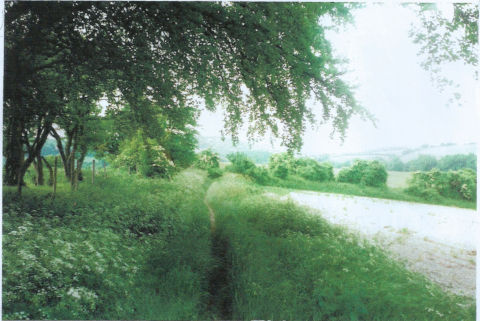 |
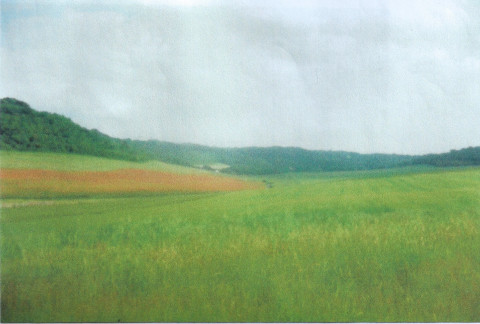 |
| East Hill looking towards Knotts Valley | Knotts Valley - big farmer! |
 |
 |
Up on the Hill
Already I had noticed that the houses were different. Most had been built of timber in the early 1920's by hopeful potential small-holders who had bought plots of land carved from a large estate. Plots were mostly three acres, but unfortunately, as the smallholders soon found out, at such an altitude the remote plot areas were not large enough to support a sustainable lifestyle. However those early settlers set to and built their own single storey houses of timber. Some were coated with tar as a preservative, and some were built with large glass lean-tos on the east side. I learnt that this design feature was very useful as the hill had a 'mini-clime' which strictly governed local temperature and length of the growing season. Spring came late. Autumn came early. Many days cold mists did not move.
Lean-tos on the houses helped keep warm kitchens and houses, and provided valuable easily accessible 'greenhouse' space for starting off plants. Another important aspect of the 'lean-to's was that they extended the roof water catchment area. Water was then directed into a large cistern in the ground just outside the back door, or to a cistern or two set below the kitchen floor.
I walked down the lane to my destination. In the hedge were blackthorn, hawthorn and spindle, all carrying berries - feed for resident birds. These usually kept to patches of thick woodland that had missed being cleared. There were a few mature oak and beech over a hundred years old, but I noticed in later years that those trees were vulnerable to speedy wind draughts coming up denuded chalk gullies. Birds made the best of things. They had become shy due to the influx of humans but over the years I was lucky enough to view one or two very closely. There was the little brown tree-creeper propping itself up on a spread of its stiff tail feathers as it moved up a tree probing the bark with its needle-like beak. Inches away was a pretty nuthatch. Both were working in woodland edge trees or I would never have seen them. Neither was concerned about my presence.
Another woodland edge bird was a woodlark and that literally came down to see what I was doing. In the lane hedges there were gold crests and yellow hammers. I did see a mistle thrush and a big green woodpecker near a stand of mature oak and beech. Visiting redwings regularly overwintered on the garden plot just up from the chalk bank where the wild orchids grew. In the spring came the cuckoo to untouched woodland.
And there, one year, I heard a nightingale.
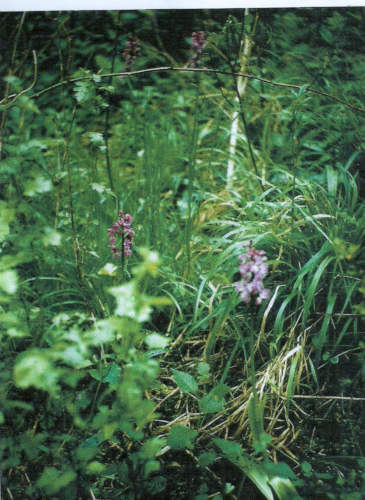 |
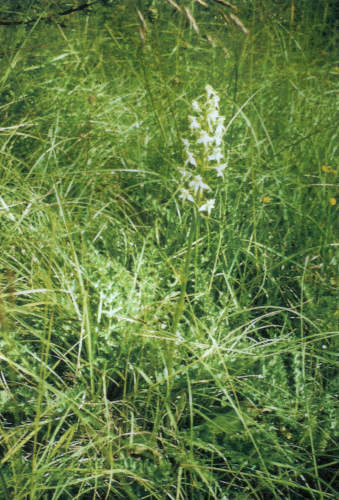 |
| Early Purple Orchid (Orchis mascula) | Greater Butterfly Orchid (Anacomptis pyramidalis") |
 |
 |